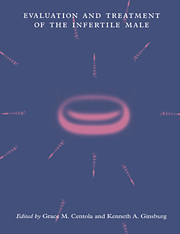Book contents
- Frontmatter
- Contents
- Preface
- List of contributors
- 1 Andrology
- 2 Sperm–egg interaction
- 3 Routine semen analysis
- 4 Computer-aided sperm analysis: a critical review
- 5 Antisperm antibodies: diagnosis and treatment
- 6 The sperm penetration assay
- 7 Intrauterine insemination for male factor
- 8 Processing human semen for insemination: comparison of methods
- 9 New assays for evaluating sperm function
- 10 Assisted reproductive technology for male factor infertility
- 11 Microinjection techniques for male infertility
- 12 Therapeutic donor insemination: screening, indications and technique
- 13 Endocrine assessment and hormone treatment of the infertile male
- 14 The urologic evaluation of the infertile male
- 15 Azoospermia: the diagnosis and treatment
- 16 White blood cells in semen and their impact on fertility
- 17 Psychological aspects of male infertility: lifting the shroud of shame
- 18 Evaluation of the female partner
- Index
1 - Andrology
Published online by Cambridge University Press: 16 September 2009
- Frontmatter
- Contents
- Preface
- List of contributors
- 1 Andrology
- 2 Sperm–egg interaction
- 3 Routine semen analysis
- 4 Computer-aided sperm analysis: a critical review
- 5 Antisperm antibodies: diagnosis and treatment
- 6 The sperm penetration assay
- 7 Intrauterine insemination for male factor
- 8 Processing human semen for insemination: comparison of methods
- 9 New assays for evaluating sperm function
- 10 Assisted reproductive technology for male factor infertility
- 11 Microinjection techniques for male infertility
- 12 Therapeutic donor insemination: screening, indications and technique
- 13 Endocrine assessment and hormone treatment of the infertile male
- 14 The urologic evaluation of the infertile male
- 15 Azoospermia: the diagnosis and treatment
- 16 White blood cells in semen and their impact on fertility
- 17 Psychological aspects of male infertility: lifting the shroud of shame
- 18 Evaluation of the female partner
- Index
Summary
History of andrology
According to Taber's Cyclopedic Medical Dictionary, ‘andrology’ is defined as the study of diseases of men, especially of the male genital organs (Thomas, 1989). Introduction of the term ‘andrology’ is credited to a gynecologist, Harald Siebke, a Professor of Gynecology in Bonn, Germany (Schirren, 1984). Professor Siebke used this term first in 1951 with the intention of demonstrating that the male and female are equally important in reproduction. Truer words have never been spoken! Although andrology refers to a study of male infertility, in the broadest sense, andrologists not only study the clinical aspects of male fertility, but also study the biological mission of the sperm, from production in the testes, to interaction with, and penetration of the oocyte at the time of fertilization.
Andrology as a science has made tremendous developments in the past 40 to 50 years. There are now national and international membership organizations (The American Society of Andrology), as well as national and international peer-reviewed journals (Journal of Andrology, Andrologia) devoted specifically to the field of andrology.
Leeuwenhoek and the discovery of spermatozoa
For centures, the theories of generation presented by Aristotle (reviewed by Schierbeek, 1959) were universally accepted. Aristotle believed that the male principle contained the efficient cause of generation and the female the material of it. Aristotle, in discussing whether semen comes from all parts of the body, wrote that the nature of semen is to be distributed to the whole of the body. Furthermore, Aristotle pointed out that the potential parts of the whole organism were found in the semen, not in the female.
- Type
- Chapter
- Information
- Evaluation and Treatment of the Infertile Male , pp. 1 - 5Publisher: Cambridge University PressPrint publication year: 1996



